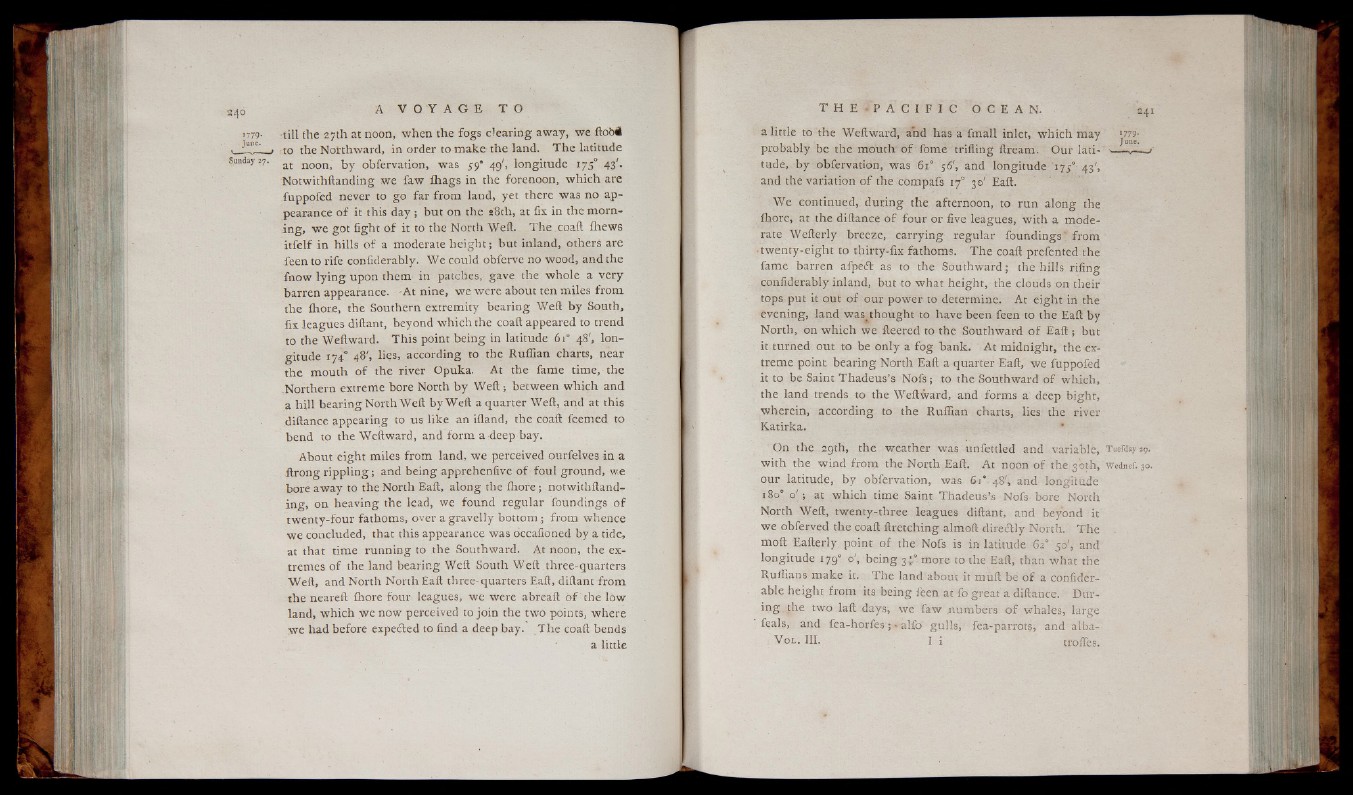
till ihe 27th at noon, when the fogs clearing away, w e ftobi
to the Noi'thward, in order to m ake the land. T h e latitude
at noon, b y obfervation, was 59“ 49', longitude 1750 43'.
Notwithftanding we faw fhags in the forenoon, w hich are
fuppofed never to go far from land, yet there was no appearance
o f it this day ; but on the 28th, at fix in the mornin
g , w e got fight o f it to the North Weft. T h e coaft ihews
it fe lf in hills o f a moderate h e ig h t ; but inland, others are
feen to rife confiderably. We could obferve no wood, and the
fnow ly in g upon them in patches, gave the whole a ve ry
barren appearance. -At nine, we were about ten miles from
the fhore, the Southern extremity bearing Weft by South,
fix leagu es diftant, beyond w hich the coaft appeared to trend
to the Weftward. T h is point being in latitude 6 r 48', longitude
174° 48', lies, according to the Rullian charts, near
the mouth o f the river Opuka. At the fame time, the
Northern extreme bore North b y W e ft ; between which and
a h ill bearing North Weft by Weft a quarter Weft, and at this
diftance appearing to us like an ifland, the coaft feemed to
bend to the Weftward, and form a deep bay.
About eight miles from land, we perceived ourfelves in a
ftrong r ip p lin g ; and being apprehenfive o f foul ground, we
bore awa y to the North Eaft, along the ihore ; notwithftandin
g , on heaving the lead, we found regu lar foundings o f
twenty-four fathoms, over a g rav elly bottom ; from whence
we concluded, that this appearance was bccafioned by a tide,
at that time runn in g to the Southward. At noon, the extremes
o f the land bearing Weft South Weft three-quarters
Weft, and North North Eaft three-quarters Eaft, diftant from
the neareft ihore four leagues, we were abreaft o f the low
land, which we now perceived to join the two points, where
w e had before expedted to find a deep bay. T he coaft bends
a little
a little to the Weftward, and has a fmall inlet, w hich may '779.
probably be the mouth o f fome trifling ftream. Our lati- >-— i— ~i
tade, by obfervation, was 61° 56', and longitude 175° 43',
and the variation o f the compafs 17° 30' Eaft.
We continued, during the afternoon, to run along the
Ihore, at the diftance o f four or five leagues, with a moderate
Wefterly breeze, carrying regu lar foundings ‘ from
•twenty-eight to thirty-fix fathoms. T he coaft prefented the
fame barren afpedt as to the Southward; the hills riling
confiderably inland, but to what height, the clouds on their
tops put it out o f our power to determine. At e ight in the
evening, lan d wast thought to have been feen to the Eaft by
North, on w h ich we fleered to the Southward o f E a ft ; but
it turned out to be only a fo g bank. At midnight, the extreme
point bearing North Eaft a quarter Eaft, we fuppofed
it to be Saint Thadeu s’s N o fs ; to the Southward o f which,
the land trends to the Weftward, and forms a deep bight,
wherein, according to the Ruffian charts, lies the river
Katirka.
On the 29th, the weather was unfettled and variable, TueHay 29.
w ith the wind from the North Eaft. At noon o f the 30th, Wednef. 30.
our latitude, by obfervation, was 6i* 48', and longitude
180° o '; at which time Saint Thadeus’s Nofs bore North
North Weft, twenty-three leagues diftant, and beyond it
w e obferved the coaft ftretching almoft diredlly North. T he
moft Eafterly point o f the Nofs is in latitude 62° 50', and
longitude 179° o', being 34° more to the Eaft, than what the
R.uffians make it. T he land about it mu ll be o f a confider-
able height from its being feen at fo great a diftance. Durin
g , the two laft days; we faw numbers o f whales, large
feals, and fea-horles ; •* alfo gu lls, fea-parrots, and alba-
. V ol. Ill, 1 i trofies.